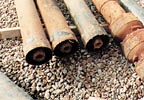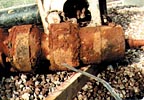Iron bacteria severely reduces a well's efficiency.
In some areas, a common well maintenance issue is the growth and accumulation of iron bacteria. The iron bacteria grow on the pump and well screen and within the surrounding aquifer formation. The iron bacteria form large masses of a brown, sticky, gelatinous substance. Without proper remediation and regularly scheduled maintenance, the bacteria can significantly reduce the efficiency of a water well in a short period of time.
Iron Bacterial Growth
There are a number of different species of iron bacteria that can affect a water well. The bacteria generally are long, threadlike organisms that secrete a slime. The slime allows the bacteria to adhere to a substrate and also forms a protective sheath. New bacterial growth will occur on top of older growths, forming a layer-like structure. The result is large masses of brown gelatinous bacterial growths that can quickly plug screen openings and pump intakes.

|
| Iron bacteria can cause a host of problems for wells, such as coating the drop pipes and pumps. Photos courtesy of Meyer Groundwater Services. |
In general, the bacteria grow by producing enzymes that catalyze - or promote - chemical reactions involving iron within the ground water. A by-product of the chemical reaction is the release of a small amount of energy that the bacteria then use to grow and multiply. The chemical reaction involves the oxidation of ferrous iron (Fe2+) that is in solution to a ferric iron (Fe3+). The iron bacteria convert ferrous iron to ferric iron as follows:
Fe2+ (dissolved iron in water) + H+ + 1⁄4 O2 ' Fe3+ + 1⁄2 H2O
The ferric iron (Fe3+) then reacts with water to form an insoluble iron hydroxide (Fe(OH)3) as follows:
Fe3+ + 3H2O ' Fe(OH)3 (insoluble precipitant) +3H+
Similar reactions also can occur with manganese forming insoluble precipitants. In general, the environmental controls that are necessary for bacteria to grow are: 1) source of ferrous ions (dissolved iron), 2) oxygen and 3) proper pH. Ferrous iron generally is created in an anaerobic (lacking oxygen) environment that occurs in fine-grained material or aquifers at depth. When a water well is drilled, an area around the well screen and pump exits that consist of an aerobic - higher concentrations of oxygen - environment surrounded by the lower oxygenated, or anaerobic, aquifer environment at depth. This condition provides a perfect environment for aerobic iron oxidizing bacteria to exist. The anaerobic areas adjacent to the well produce and supply ferrous iron that acts as an energy source for the bacteria. The oxygenated environment within the well screen and pump area allows for the enzymatically catalyzed oxidation of the ferrous iron that the bacteria utilize to grow and reproduce.
The bacteria plug the pump intakes, screen openings and pore spaces in the aquifer adjacent to the well by three main mechanisms:
a. Bacterial mass
b. Formation of insoluble iron and manganese hydroxides
c. Fine-grained sediment adhering to the sticky gelatinous covering of the bacteria
Remediation Techniques
Successful remediation of iron bacteria consists of two steps: 1) the breakup and removal of the bacterial mass and associated insoluble precipitants and 2) sterilizing the well screen, pump and adjacent aquifer area to reduce the remaining residual bacteria population. It is almost impossible to completely remove all the bacteria. The bacterial populations will increase with time, and either additional remediation events will be necessary or regularly scheduled maintenance disinfections will be required. The two most common methods to remediate iron bacteria are through the use of acids and oxidizers.
It is strongly recommended that the water system operator contact the manufacturer before using any chemical treatment for instructions regarding the safe handling and use of any chemicals and recommended personal protective equipment.
There are a number of manufacturers that produce remediation chemicals. Be sure to contact a manufacturer regarding costs, options and specifications.

Oxidizers
Oxidizing agents will chemically react and dissolve the bacterial mass. The most commonly used oxidizer is chlorine in the form of household bleach. Household bleach usually is available as a 5.25-percent sodium hypochlorite solution. Wells that have a significant bacterial mass require concentration of free chlorine greater than 1,000 milligrams per liter (mg/L) to remediate the well. Creating concentrations of this magnitude is referred to as “shock chlorination.” The necessary quantities of household bleach to produce 1,000 mg/L in various diameter wells can be seen in Table 1.

As the chlorine reacts with bacteria, it is recommended to physically agitate the water in the well. The physical agitation is necessary to break up the bacterial mass (layering) exposing more bacteria to the chlorine solution, force the chlorine solution through the screen and into the surrounding formation where bacteria may also be clogging the pore spaces and physically break apart the associated insoluble hydroxides that chlorine is not effective at removing. The two most common methods are surging with a surge block and jetting. Jetting generally is recommended because it concentrates the most energy and would be more effective in removing insoluble hydroxides.
The recommended procedure for chlorination of a water well:
1. Remove both the pump and pump column.
2. Add the proper amount of bleach to produce concentrations of approximately 1,000 mg/L (see table 1).
3. Recommended contact time is 24 hours.
4. The well should be agitated every three to four hours using either a surge block or jetting.
5. The pump and pump column should be cleaned with 1,000-mg/L bleach solution.
6. Lower pump and pump column into well.
7. Purge the well until chlorine concentrations are reduced to negligible levels. Chlorine concentration kits are available from water conditioning/treatment or pool supply businesses.
8. Purged water should be treated and/or disposed of in an approved manner. Contact your local regulatory agency for approved disposal/treatment options.
9. Measure pump rate and drawdown on a regular schedule and determine specific capacity (pump rate divided by the drawdown).
10. When the specific capacity decreases by approximately 10 percent to 20 percent, then a maintenance disinfection should be performed.
11. In order to perform maintenance disinfection:
a. Shut off the pump.
b. Add enough bleach to produce a concentration of 500 mg/L.
c. Leave in the well for approximately 24 hours.
d. Purge the well until chlorine concentrations are reduced to negligible levels. Chlorine concentration kits are available from water conditioning/treatment or pool supply businesses.
e. Purge water should be treated and/or disposed of in an approved manner. Contact the local regulatory agency for approved disposal/treatment options.
Acidifiers
Acid treatment is effective as a bactericide and removing insoluble hydroxides by lowering the pH below 2. Commonly used acidifiers are hydrochloric acid, sulfuric acid and hydroaceitic acid. The acids can be obtained in liquid, powder and pelletized forms. Hydrochloric and sulfuric acids are mineral or inorganic acids, and hydroacetic acid is an organic acid. Inorganic acids are effective at removing insoluble iron and manganese precipitants. Organic acid is effective at breaking apart and removing sticky bacteria masses and carbonate scale. The most effective treatment for iron bacteria and the associated insoluble deposits is the use of a combination of inorganic and organic acids.
The use of acids have potential drawbacks that include damage to well screens and the re-precipitation of scale that goes into solution from the acid treatment. Various other chemicals such as inhibitors can be added to help protect the screen from attack by the acid and chelating agents that keep the dissolved precipitants in solution. There are commercially available products that have a mixture of chemicals to break apart and kill iron bacteria and insoluble precipitants along with inhibitors and chelating agents to help protect the screen and keep dissolved material suspended in solution. It is recommended to use a commercially available mixture.
The recommended procedure for remediating a biofouled water well with acid is as follows:
1. Remove both the pump and pump column.
2. Add the proper amount and combination of acid products as instructed by the manufacturer. Generally the products would be introduced into the well through a tremie pipe. The pipe is extended from the surface to the screen area to introduce the acid products directly to the screen area so that it will not be diluted through the water column.
3. Recommended contact time generally is 24 to 48 hours. If greater contact times are used, then the chelating agent becomes less effective and may result in re-precipitation of insoluble precipitants.
4. The well should be agitated every three to four hours using either surge block or jetting.
5. The pump and pump column should be cleaned with either a 1,000-mg/L bleach solution or acid treatment as directed by the manufacturer. The pump and pump column should then be rinsed with clean preferably purified water.
6. Lower pump and pump column into well.
7. Purge well until pH is raised to pre-treated levels. Kits to measure pH are available from water conditioning/treatment or pool supply businesses.
8. Purge water should be treated and/or disposed of in an approved manner. Contact the local regulatory agency for approved disposal/treatment options.
9. Measure pump rate and drawdown on a regular schedule and determine specific capacity (pump rate divided by the drawdown).
10. When the specific capacity decreases by approximately 10 percent to 20 percent, then a maintenance disinfection should be performed.
11. In order to perform maintenance disinfection:
a. Shut off the pump.
b. Add the proper amount of acid products as instructed by the manufacturer.
c. Leave product in the well for approximately 24 hours.
d. Purge the well until pH is raised to pre-treated levels. Kits to measure pH are available from water conditioning/treatment or pool supply businesses.
e. Purge water should be treated and/or disposed of in an approved manner. Contact the local regulatory agency for approved disposal/treatment options.



Report Abusive Comment